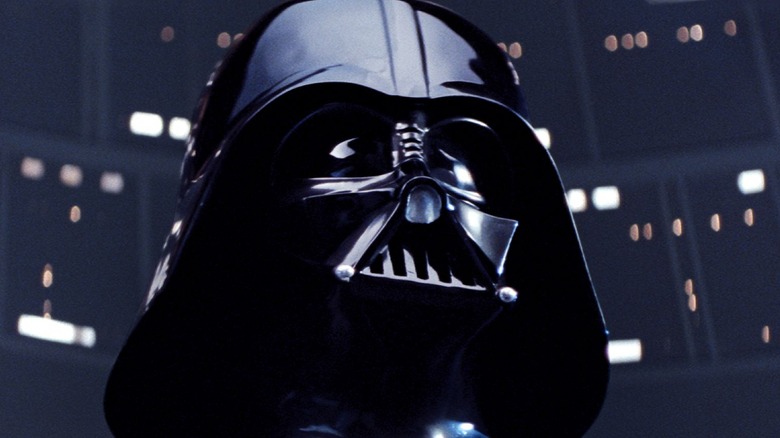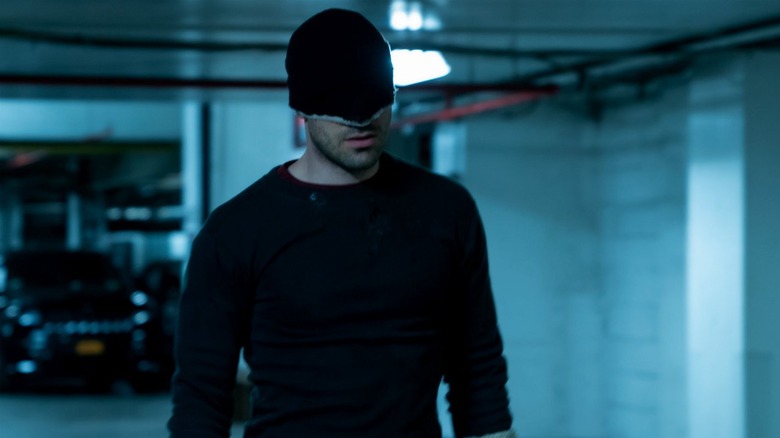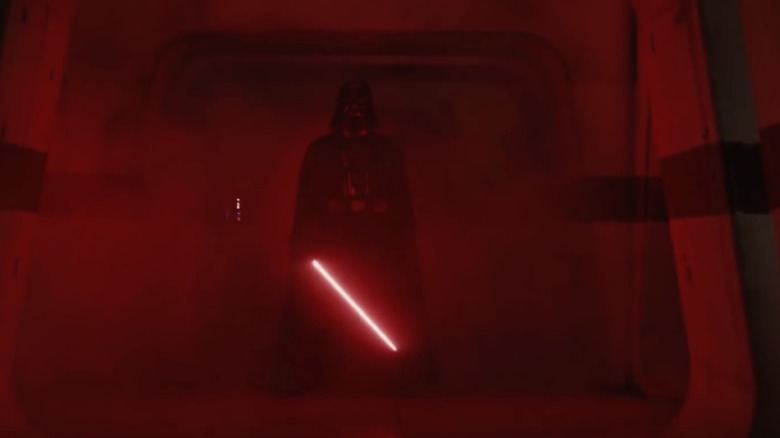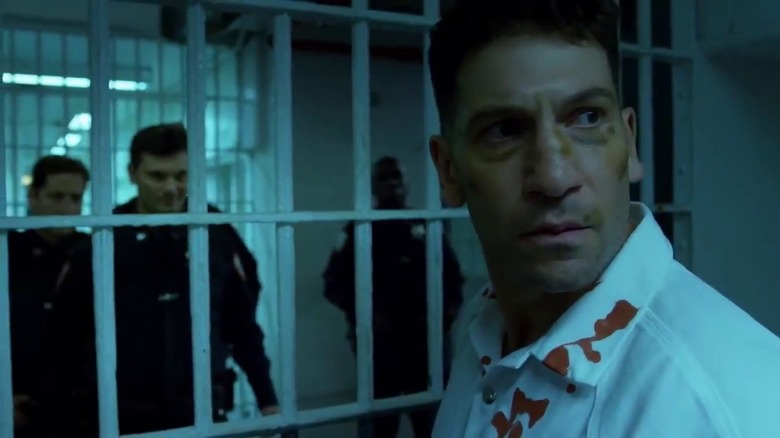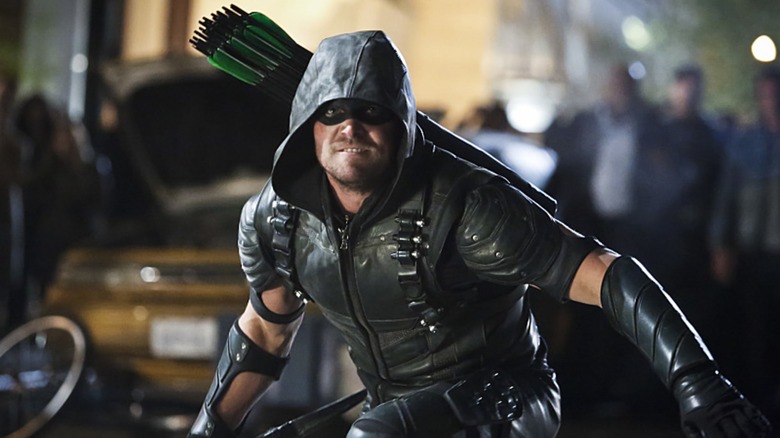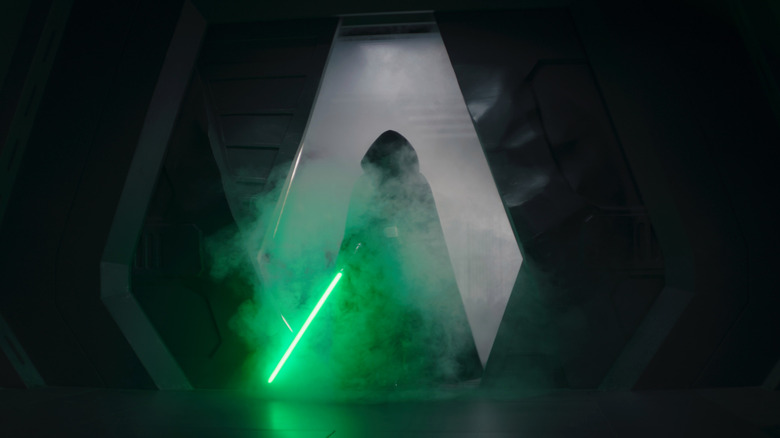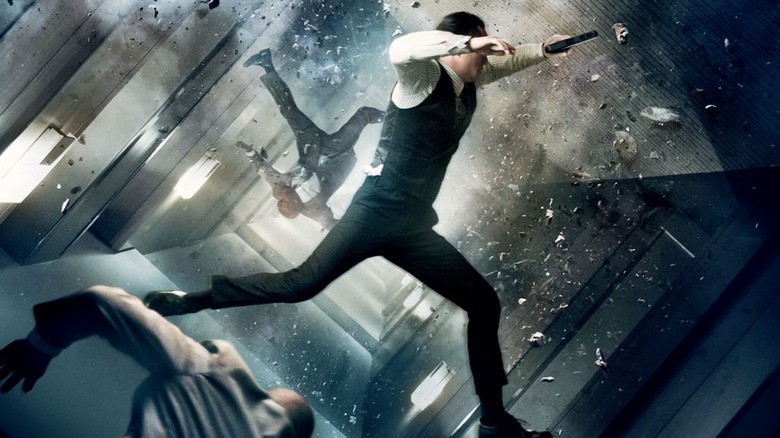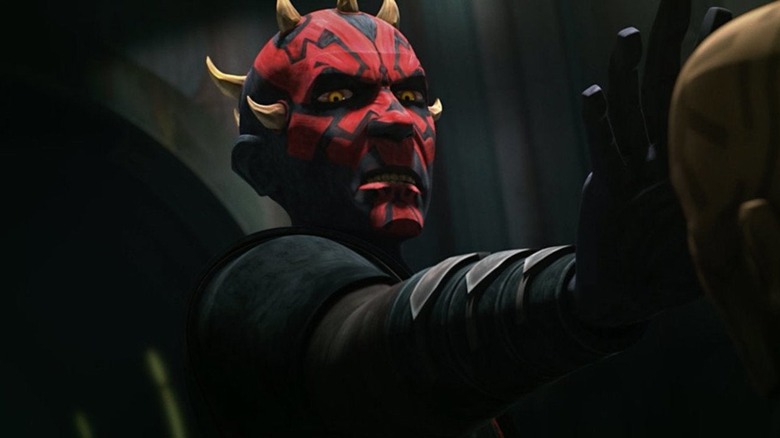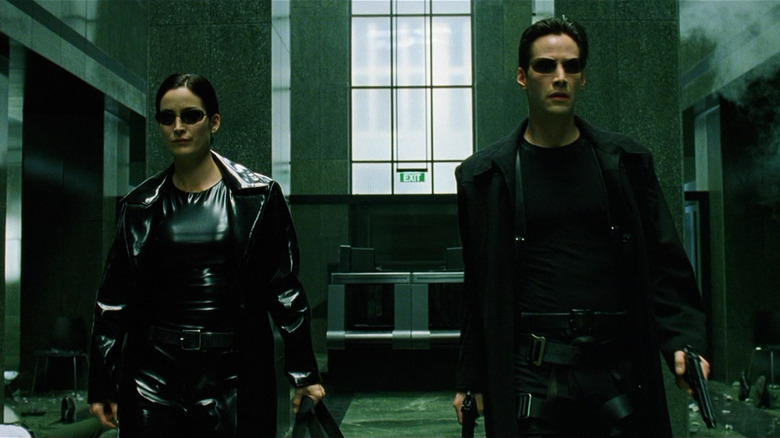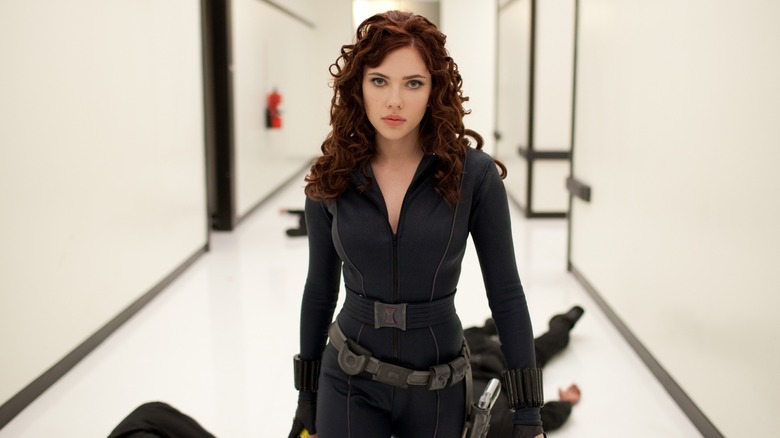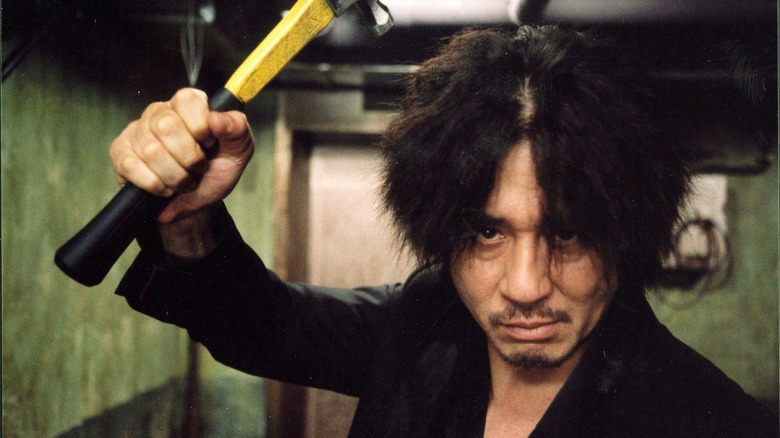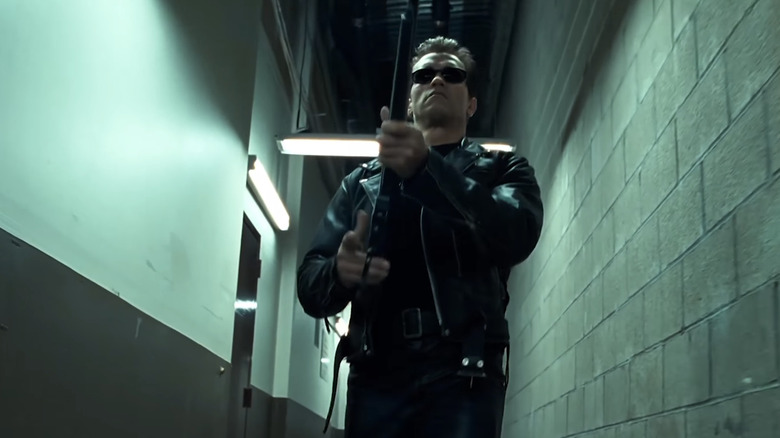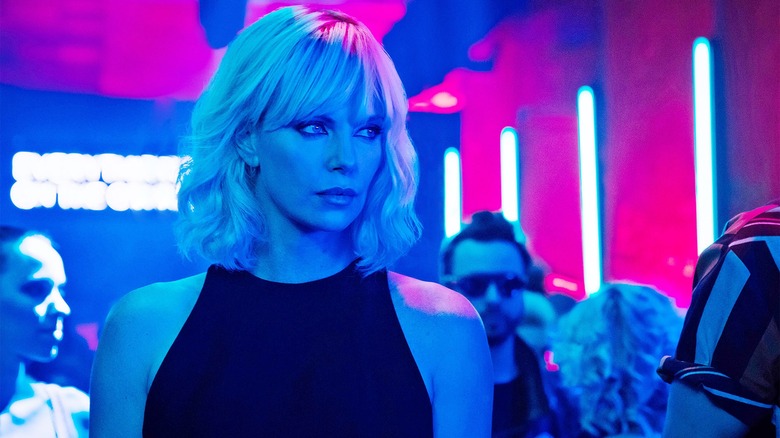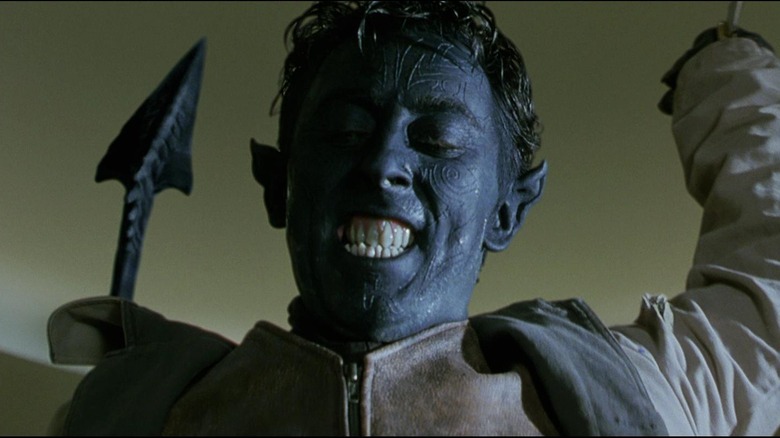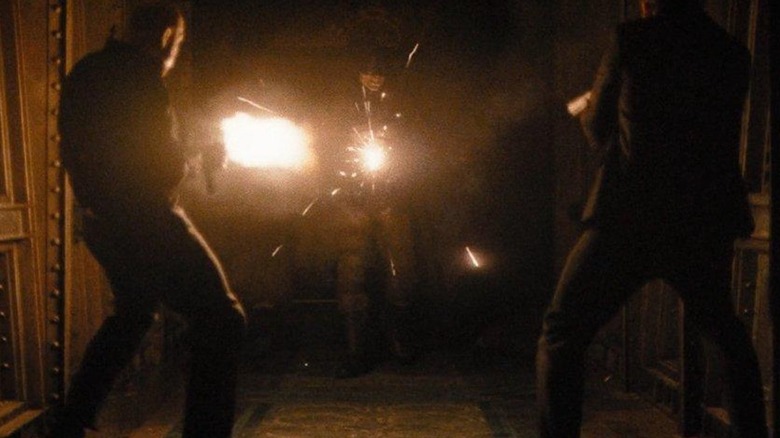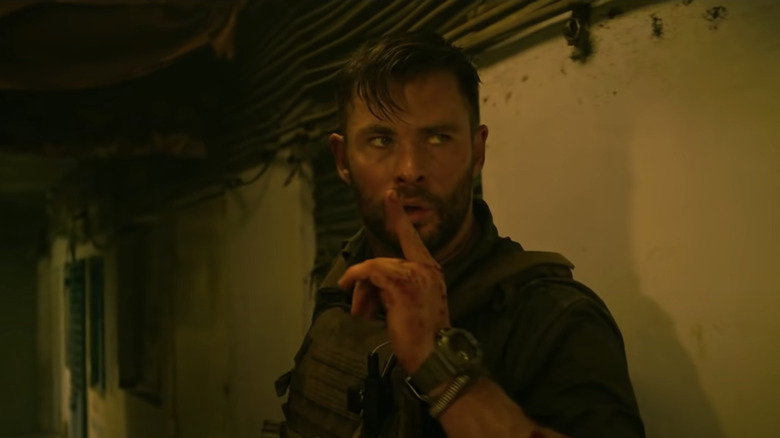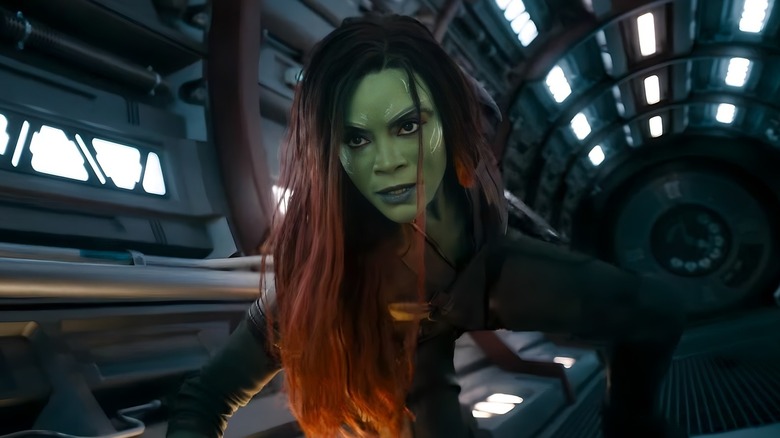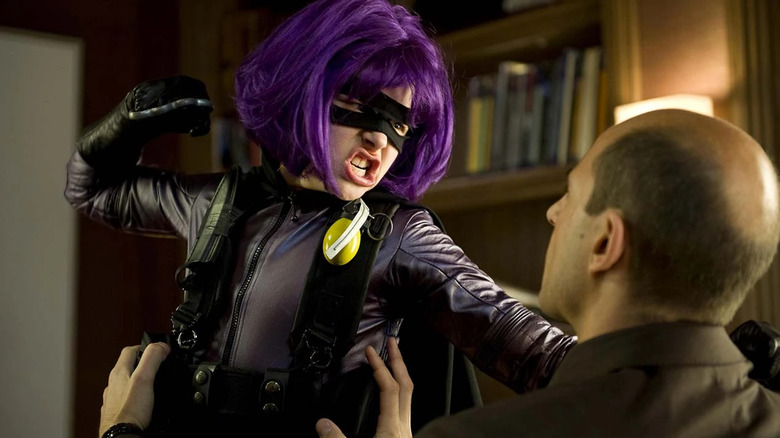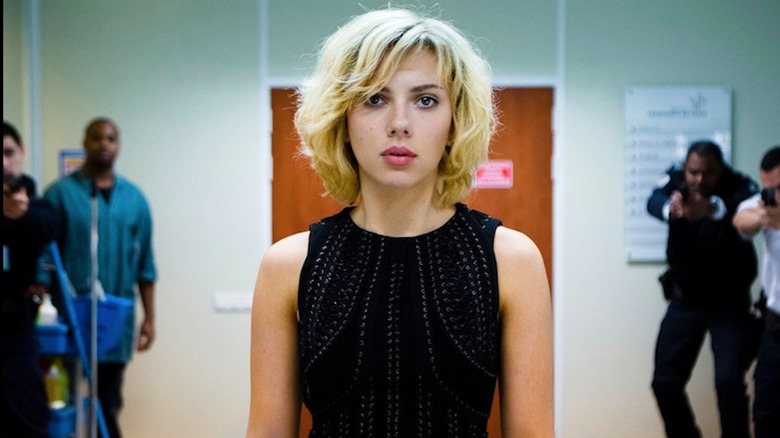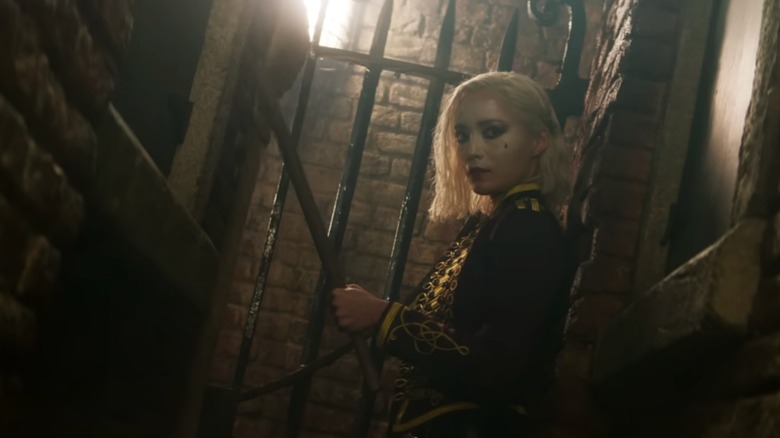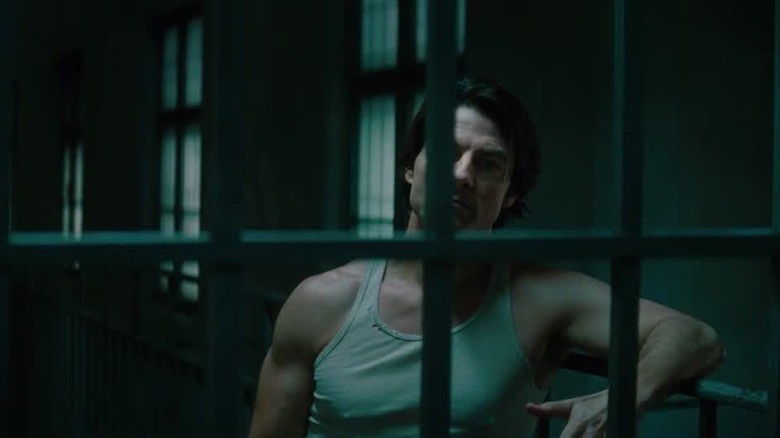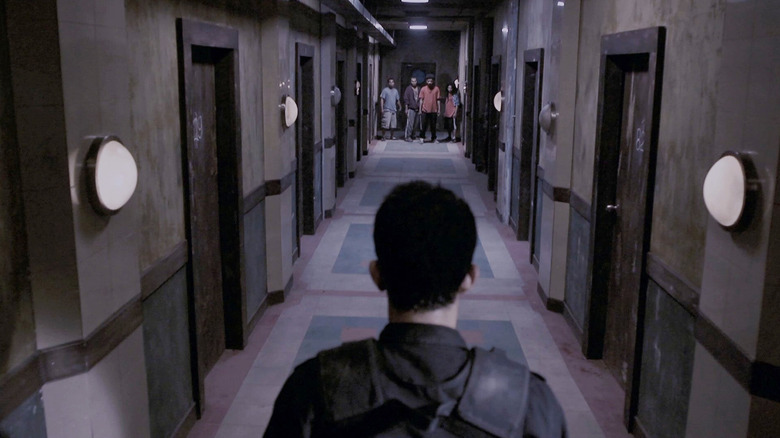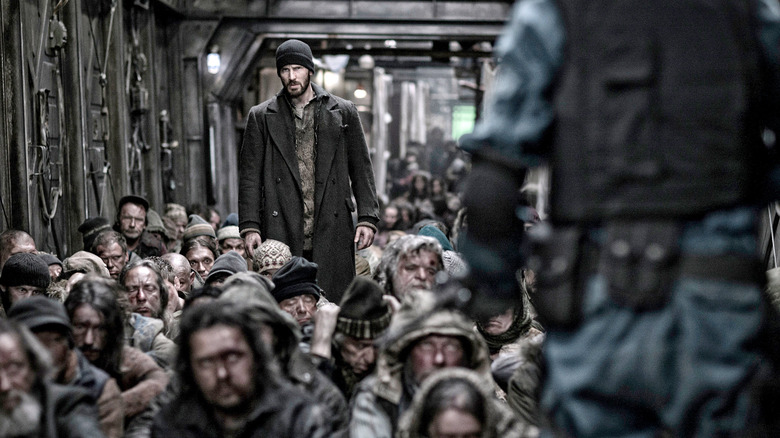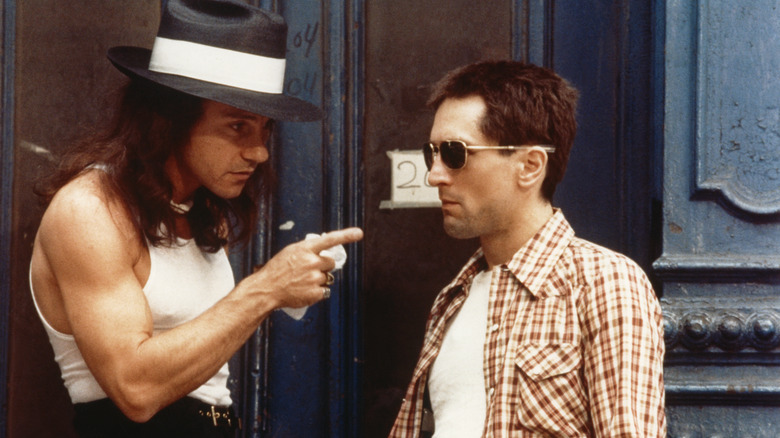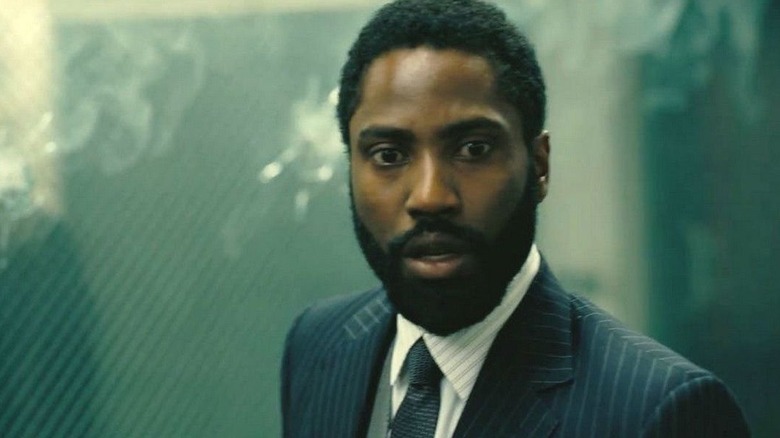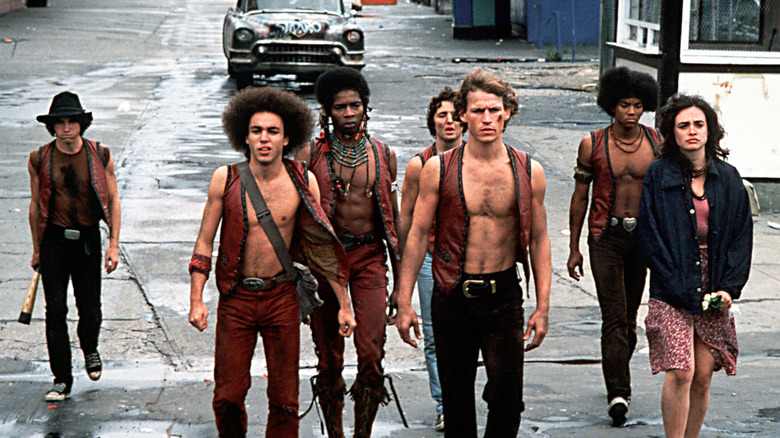The Best Action Scenes That Take Place In A Hallway
When Darth Vader lit up the darkened corridor of a rebel ship with his crimson lightsaber at the end of "Rogue One," moviegoers fell in love with the idea of the hallway fight scene. Increasing in pop culture frequency since, and often referred to as "hallway scenes" in Star Wars circles, these fights form their own type of film combat subgenre, complete with its own features and tropes.
These scenes tend to follow a formula where someone fights waves of henchmen, slicing through them like a hot knife through butter, while confined within extremely close quarters — all the better to showcase the fighter's unmatched combat prowess. Despite the name, the scenes don't always necessarily take place in hallways, and can sometimes showcase a small group of fighters instead of a single person.
When done correctly, the raison d'etre for a hallway fight scene is simple: it's really, really fun to watch. As you'll see below, the best examples combine spectacular, creative, imaginary choreography, bringing power to bear on a mass of unprepared, unsuspecting victims. After you give our list a read, be sure to track down these scenes — each is like its own tiny shot of adrenaline.
Matt Murdock on Daredevil
When the Netflix "Daredevil" series debuted in 2015, it had its fans. But when they got to "Cut Man" (Season 1, Episode 2), it seemed like the entire pop culture universe had its collective jaw on the floor.
In retrospect, the final scene of the second episode was where the series really took off. Just beginning his fight as "the man in black," Matt Murdock has been pushing back against the rising criminal empire exploiting Hell's Kitchen, and it has come time for the mafia to respond in kind. Determined to squash the vigilante before he inspires others to follow his lead, gangsters kidnap a small boy to lure Murdock into a trap — and when he learns the location of the child, it's time for a confrontation.
It's an incredible scene. The entire fight is an uninterrupted, three-minute-and-one-second shot of Murdock moving from room to room within a rundown apartment building searching for the boy — and keep in mind, the character is blind and relying completely on his other sense. Engaging what feels like it must be every mobster in the state of New York, he kicks and punches (and takes his share of hits too) until he locates the boy. Telling the child he doesn't need to be afraid anymore, Murdock carries him out of this hell hole, stepping over the masses of moaning men he'd beaten down to get there.
The cinematography alone could have put this scene on a "best of" list, but it excels in every other sense as well. The corridor is dimly lit and atmospheric. The sound is muted and moody until the violence begins, and then shifts to an emotional, hopeful theme as he leaves with the child. The choreography doesn't let up for a second, leaving us with a vivid image of how hurt and exhausted Murdock becomes as he doggedly makes his way to his target — and speaks volumes about a character who will go to such lengths to save an innocent life.
Darth Vader in Star Wars: Rogue One
The most famous scene of 2016's "Rogue One: A Star Wars Story" used the hallway fight concept in a very unique way. While many instances of these fights utilize the cramped quarters and army of combatants to create a sense of danger for the safety and victory of the protagonist, this Star Wars scene employed the same tropes to make the viewer afraid for everybody else.
At this point in the movie, the Rebels have done everything in their power to capture the Death Star plans, and they finally have them in their grasp. The entire cast of the film died to get the Alliance to this key point — and then a door doesn't open, and at the other end of the hallway, the soldiers hear the most iconic breathing in cinema.
Once the crimson lightsaber ignites, filling the room with its glow, you know it's over. This is Darth Vader in his prime, Force-throwing enemies, yanking the weapons out of their hands with a casual gesture, deflecting their shots with ease. The lighting, sound design, and choreography create a sense of dread, a fear everything that came before this might be for naught. Vader's lightsaber provides the only light in the hallway, while Michael Giacchino's score strikes a grand note of horror punctuated by the terrified rebel soldier banging on the glass window like he's fresh meat in an '80s slasher movie.
It takes the Sith lord about a minute to make his way through the ship, and there is nothing the rebels can do to stop him. Vader doesn't change his pace once during the scene, toying with his enemies. For everyone who grew up with the original trilogy, this was a most-welcome glimpse at what the most evil man in the galaxy far, far away looked like long before he removed his helmet and lost his mystery.
Frank Castle on The Punisher
It's crazy to think that after several movies and decades of comics, Marvel still felt the need to slowly introduce The Punisher on its "Daredevil" Netflix show, rather than just giving him his own series right away. Honestly, if they needed proof Frank Castle could handle it, all they had to do was watch the hallway fight scene in "Seven Minutes in Heaven" (Season 2, Episode 9) of "Daredevil."
At this point, Daredevil had finally put Castle (Jon Bernthal) in prison, but the man was no less a danger to those around him.
The set-up was simple: The imprisoned Wilson Fisk, who had challenged Daredevil throughout Season 1, manipulates Castle into killing the current "Kingpin" of the prison so that Fisk can take his place. To cover his tracks, has Castle locked in a hallway and lets loose an army of inmates to kill Castle.
The result is brutal, the music is sparing, and we hear the sounds of each strike, allowing the choreography to get the spotlight. It feels like a conscious effort to top the "Cut Man" scene, and it may just have succeeded. But in this fight, there's no darkness to hide behind; it's all brightly lit, exceptionally intimate, and splattered in blood. At various points in the fight, Castle impales inmates, gouges an eye out, and is forced to pull a knife out of his own arm so that he can use it against an attacker.
The scene even uses color to tell its story. The dark uniforms of the guards who trap Castle and the bright orange jumpsuits of the inmates who attack him stand out considerably against Castle's white uniform and the drab grey of the hallway. These comparatively mundane colors highlight every drop of blood spilled throughout the fight, visually exhibiting the escalation of violence while simultaneously displaying Castle's ever-diminishing sanity and claim to innocence.
Green Arrow (and friends) in Brotherhood
The Green Arrow and his allies (Speedy, Spartan, Atom, and the Black Canary) spent Season 4 battling the mystical Damien Darhk and his "HIVE" of mercenaries. When they discovered that Spartan's brother Andy had been brainwashed into joining HIVE, Team Arrow staged an all-out assault on HIVE's headquarters to capture and bring him home. "Brotherhood" (Season 4, Episode 7) was the first episode directed by James Bamford, the show's primary fight coordinator, and that shone through in the best way.
Though the need to cut to various set pieces keeps the scene from being a true single-take fight sequence, every piece of it is captured in long-form shots, allowing Bamford's fight choreography to truly shine as the team of heroes takes on a literal army. Green Arrow spends most of the fight in the main courtyard, alternating between ranged and close-quarters combat seamlessly, and when the Atom drops out of the sky in his powered armor and starts beating down mercenaries with metallic clangs, the show fully earns its superhero moniker.
The most impressive portion of the fight, however, is a more traditional "hallway scene" that follows Speedy (Green Arrow's sidekick) as she attempts to take down the brainwashed Andy by herself. The bulk of the fight is one incredible shot that follows the two as they fight down one hallway, into an elevator, and out onto a different floor before Speedy finally subdued him, which likely required a complete set change in the moments when the elevator doors were closed.
Luke Skywalker on The Mandalorian
No, this isn't a Star Wars movie you somehow missed. But it's as good as one, and it came about via a "Mandalorian" episode called "The Rescue" (Season 2, Episode 8).
The entire episode built to this hallway scene. Din Djarin (the titular Mandalorian) and his crew had boarded an Imperial cruiser to rescue the Child, thinking they could take down the ship's stormtroopers easily. Djarin, however, was barely able to defeat one lone robotic Dark Trooper after an epic battle — so when a whole team starts making their way towards our heroes, things look grim.
Accompanied by Ludwig Göransson's chilling electronic theme, the Dark Troopers' ominous march is soon replaced by the sound of the droids beating down the reinforced bridge doors with their bare hands.
Then a single X-Wing arrives. The music completely shifts gears into a comparatively tranquil melody, and both the audience and Djarin watch as one, single Jedi calmly and effortlessly slices his way through every single droid. When the doors open, the legendary Luke Skywalker steps out and takes Grogu away to train.
The scene is a brilliant inversion of Darth Vader's aforementioned "Rogue One" scene, further establishing the symmetries between father and son. Where Vader's arrival brought despair and death, Luke's was accompanied by hope and salvation. The visual and auditory contrast between Vader's rage-fueled slaughter and Luke's methodical dismantling might just be the best representation of the differences between the Jedi and the Sith in all of Star Wars.
Arthur in Inception
Not only is it one of the best hallway fight scenes on this list, this moment from "Inception" is also one of the most impressive fights in all of cinema. Christopher Nolan's film is famous for its mind-bending antics, and it used them to incredible impact with this set piece.
Arthur (Joseph Gordon-Levitt) is fighting within the dream world against a set of guards projected by their target's subconscious as a defense mechanism. But when the van that Arthur is sleeping in loses control and begins to roll, so too does the hotel hallway that Arthur and the guards are fighting in. Arthur and the guards have to fight while their reality literally spins around them, resulting in a visually-stunning confrontation as Arthur and the last guard fight for control of a gun.
The only thing more incredible than the scene itself is what it took to make it. Instead of relying on visual tricks or computer-generated images, Nolan and his crew built a giant centrifuge with its own hotel hallway inside of it. The filmmakers mounted a camera on the "floor" and literally spun the hallway around the actors as they fought. The scene also has a cinematic pedigree, continuing a spinning-room tradition that began with Fred Astaire's dance in "Royal Wedding" — and now, we know what that dance would have looked like if a bunch of guys had been trying to kill him.
Joseph Gordon-Levitt prepared and trained for roughly two weeks so that he could perform nearly the entire sequence himself. The fight, which took up a single paragraph within the script and lasted about thirty seconds, took three weeks to complete.
Darth Maul on The Clone Wars
The final season of "Star Wars: The Clone Wars" gave Darth Maul his own shot at a beloved "hallway scene," and though it did not reach the heights of the other Star Wars entries on this list, there was one spectacular difference that set it apart. Maul did it all of it without his lightsaber.
In "Shattered" (Season 7, Episode 11), Order 66 is issued and the Republic's clone troopers turn on the former Jedi, Ahsoka Tano. She releases Maul so that his "escape" can create the diversion she needs to discover why the clones betrayed her. When the scene starts, all the viewer sees is a group of clones running for their lives, yelling at everyone around them to retreat.
Using nothing but the Force, Maul works his way through clone after clone. Using his telekinetic abilities, the former Sith lord throws clones around like rag dolls. He chokes them, throws off their aim, and rips off floor, wall, and ceiling panels to use as both shields and weapons. Several clones are decapitated, and others lose too many limbs to count throughout the fight.
While the scene may not have the gravitas or symbolism that his fellow Star Wars characters enjoyed in their hallway moments, Maul's escape was a spectacle of power nonetheless. Add in the impressive score and incredible improvements in animation that the show was harnessing by its seventh season, and fans have a moment they will be revisiting for decades.
Neo and Trinity in The Matrix
Released over twenty years ago, the original "Matrix" film's reliance on practical effects over CGI allows one of its most famous scenes to remain just as impressive today as it was in 1999.
Armed to the teeth, Neo and Trinity set out to rescue Morpheus from Agent Smith. But first, they have to get through a lobby filled with armed guards and paramilitary forces.
The duo take care of the initial set of guards with ease, but when the soldiers move in, the scene kicks into classic Matrix mode. Combining gunplay with wall-running, kung fu, flips, and an untold multitude of practical explosions, the hallway battle is an iconic moment in the franchise.
Perhaps the most unbelievable part of this scene is that it was done using practical effects. The effects of the bullets hitting the walls and columns was achieved with a multitude of explosives called "squibs." Wires were used for the wall-running, and because of the squibs, once the directors yelled "action," it became almost impossible to see, and since it took a week to set the squibs up, it was vital that everything go smoothly. The scene's revered status in the minds of movie fans is a testament to how well they executed it.
Black Widow in Iron Man 2
Much more divisive than its predecessor, "Iron Man 2" certainly got one thing right: Natasha Romanoff, the Black Widow.
Introduced as a new assistant for Tony Stark, it became immediately clear that she was far more dangerous than she appeared. Soon enough, a hallway full of beaten-up security guards could only moan in agreement.
With an army of remote-controlled drones attacking Iron Man and War Machine and chasing them throughout the city, Happy Hogan decided to take the drones out at the source, and Natasha wouldn't let him go alone. While Happy immediately began boxing with the first guard they came across, Natasha took on everybody else.
Through a combination of electric gadgets, flash-bangs, wires, and a number of impressive flips and kicks, Natasha moved through the guards in seconds before incapacitating her final foe with a simple can of mace. Meanwhile, Happy finally defeated his lone guard, turning to discover that Natasha was gone and had left a hallway of groaning men in her wake.
The scene is a lot of fun, and an excellent introduction to an iconic Marvel character. It might be the most humorous hallway fight on this list, which makes up for its choreography not quite reaching the heights of its peers. Most silly, perhaps, is that many of Natasha's attacks somehow leave guards unconscious after simply spinning them around.
Oh Dae-Su in Oldboy
Originally released in 2003, "Oldboy" is said to be one of South Korea's cinematic masterpieces, due to its perfect realization of a neo-noir aesthetic and its pure excellence as an emotionally devastating thriller. The cherry on top, then, is its excellent action choreography, which led to one of the best single-shot fight sequences ever.
Seeking vengeance for being mysteriously imprisoned for fifteen years, the film's protagonist, Oh Dae-Su finds himself face-to-face with a hallway full of criminals who want him dead. After making sure that a man he has already beaten gets taken to the hospital, the fight begins.
Filmed in one take, the camera follows Dae-Su horizontally as he moves back and forth throughout the fight scene, carefully using the narrow confines of the hallway in order to keep his attackers from rushing him all at once. The fight is brutal, and though he does eventually win, he gets stabbed in the back and is beaten while he's down, spending a lot of the fight resting against the wall in between attackers.
The sequence ends with a glimpse of Dae-Su smiling maniacally as another group of thugs arrive on an elevator, glimpsing in horror the carnage throughout the corridor and the man who brought it about. This is followed, of course, by a shot of the elevator doors opening on a different floor moments later — and all those thugs tumbling out lifelessly.
The 101 Terminator in Terminator 2: Judgment Day
"T2" has a lot of classic scenes, but it is the hallway scene that takes a slightly different approach.
As it begins, all the audience knows is that John Connor (Edward Furlong) is in deep trouble. A state-of-the-art robotic killer (Robert Patrick) is disguised as a policeman, and seemingly has the boy trapped behind-the-scenes of a local mall. As Patrick's T-1000 closes in, an even more intimidating man begins approaching from the other direction.
Here comes Arnold Schwarzenegger's Model 101 Terminator, sent by future John Connor back in time to protect young John. He has a long flower box under his arms, and is clad in the now-iconic black leather jacket and sunglasses.
As the two converge with Connor in the middle, the anxiety reaches full tilt. Narrow hallway, nowhere to go — and the Terminator just opened up his box of roses to reveal a shotgun. Much of the sound is simple and tense — the shotgun being cocked, John Connor breathing, shots ringing out. It isn't until Schwarzenegger's character says "Get down!" to John Connor that you know who to trust.
Though the fight itself is well-executed and visually pleasing, what really makes the scene great is the suspense and tension of the build-up. If you will, this is foreplay to a hallway fight, but it is executed with perfection.
Lorraine in Atomic Blonde
As she works to protect one of her informants in "Atomic Blonde," Charlize Theron's Lorraine Broughton takes on two trained killers twice her size in a building's stairwell. Presented as a near-seamless single-shot, the fight is brutal, and forces Lorraine to utilize every skill she has to overcome the two assailants.
Though Theron's character begins the fight with a pistol, her opponents almost immediately manage to disarm her, and the remainder of the fight is a brutal, unarmed two-on-one brawl that sends combatants tumbling down the stairs multiple times as they try to end each other.
Though destructive, the fight doesn't get properly bloody until one of the thugs pulls out a knife, allowing Lorraine to disarm him, take it for herself, and finally have a weapon in the fight. She immediately incapacitates the former knife-wielder, sending both men tumbling down another set of stairs for the last time.
This fight works because it is so raw. The colors are muted and bare. The camera work is fluid, moving from one visual to the next like it's a fourth person trying desperately to avoid every blow while missing none of it. The sound design is divine; no music plays, highlighting the brutality of every strike and cry of pain — seriously, Charlize takes just as many brutal hits as she dishes out — and the emptiness of the stairwell ensures that every sickening sound reverberates throughout the space.
Nightcrawler in X2
The opening scene to 2003's "X2: X-Men United" sets the pace for the entire film, and seems neck-and-neck with Quicksilver for best scene in the entire X-Men franchise. Set to Mozart's "Dies Irae" from "Requiem in D Minor," the fight perfectly showcases just why so many people fear mutants. Here is just one, using his powers to easily infiltrate the White House and come within a whisker of killing the President of the United States.
Using instantaneous teleportation, his fantastic agility, enhanced strength, and prehensile tail, Nightcrawler (Alan Cumming) evades every single gunshot. He makes his way towards the president in an incredible visual display, leaping from wall to wall through each hallway, leaving behind a blue smoke every time he vanishes.
The music stops just long enough to build tension, as the last agents hold their ground inside the oval office. When Nightcrawler finally invades the room, the film uses slow motion to highlight just how powerless the humans are. Their mutant opponent takes them down, one-by one, before most can even attempt to stop him.
The President's saving grace is that Nightcrawler has to slow down long enough to stab him, finally giving one Secret Serviceman the opportunity to shoot him. Nightcrawler flees, the President survives but the intended message is made loud and clear: Mutants are dangerous, and humans are right to fear them.
Like many of the other scenes listed above, this opener feels both claustrophobic and well-populated, intimate and violent and minimal in its visuals but maximizing of its fight choreography. Hallway scenes are undoubtedly cool, and here's hoping the best are yet to come.
Batman in The Batman
One of the most striking set pieces in Matt Reeves' 2022 DC revamp "The Batman" takes place entirely in a darkened hallway, living up to its hero's moniker as The Dark Knight. Upon learning that Carmine Falcone (John Turturro) had Selina Kyle's (Zoe Kravitz) friend Annika killed to keep her from revealing he was a police informant, Batman (Robert Pattinson) tries to stop Selina from killing Falcone (who also happens to be her father). He follows her to Falcone's nightclub, where the mob boss' goons are waiting to take him on. But the Caped Crusader easily dispenses with them, most thrillingly in that hallway sequence.
As the scene starts, some of Falcone's men have gotten word that the Batman is in the building, and they're waiting for him at an elevator with their guns drawn. Batman has cut the power, and the only light comes from cell phone flashlights. The elevator door opens, and it's completely empty. Turns out Batman was lurking on the ceiling behind them, and the goons open fire. The light from the muzzle flashes provides brief glimpses of Batman taking on the hitmen one at a time as he moves down the corridor, bullets bouncing off his armor, until he's the last one standing. What's most thrilling about this sequence is the way it keeps so much hidden from the audience. The scene recalls the shadows of film noir, to which "The Batman" is heavily indebted.
Tyler Rake in Extraction
The one-take fight scene has been a staple of action filmmaking, and it's become increasingly prevalent with the advent of digital cameras, which allow more readily for invisible edits. One of the better examples of this is in "Extraction," Netflix's widely-viewed shoot-'em-up about black ops mercenary Tyler Rake (Chris Hemsworth), who's on a mission to save a kidnapped boy, Ovi (Rudhraksh Jaiswal), whose father is an Indian drug kingpin.
Tyler tracks Ovi to Dhaka, Bangladesh, and that's where the 12-minute one-take wonder kicks off, leading to a non-stop string of car chases, fist fights, and explosions. In the midst of all that is an impressive hallway fight that takes place in a dilapidated apartment complex. (The film's sequel, "Extraction 2," upped the ante with a 21-minute one-take action sequence.)
As gunmen search for Ovi, Tyler dispenses with them by any means necessary, be it with a knife, a gun, or his own bare hands. The bad guys are coming in from all sides, eventually swarming Tyler, and Ovi has to make a run for it. He tries to hide out in an apartment, but one of the armed mercenaries finds him and tries to drag him out. Ovi slips out of his bulletproof vest and makes a run for the backdoor, where Tyler is waiting with his gun drawn. It's exciting to watch director Sam Hargrave's camera weave along the narrow corridors and balconies of the apartment complex, never losing track of our hero and the boy he's sworn to protect.
The Guardians of the Galaxy in Guardians of the Galaxy Vol. 3
James Gunn wrapped up his "Guardians of the Galaxy" trilogy with a bang, offering a fitting farewell to this lovable band of misfits before assuming his role as head honcho of DC Films. Gunn's final outing for the MCU finds the Guardians racing against time to save Rocket (Bradley Cooper). They eventually cross paths with the High Evolutionary (Chukwudi Iwuji), the evil scientist who experimented on Rocket years ago. Now, the High Evolutionary wants Rocket back so he can use him to create a utopian society of perfect beings. During their rescue mission, the Guardians discover that he's imprisoned thousands of genetically altered animals and humanoids, all of whom need saving.
When the Guardians board the High Evolutionary's ship, they're greeted by a nasty gang of snarling aliens intent on stopping them. The two sides engage in a lengthy hallway fight, captured in one continuous shot and scored to The Beastie Boys' anthem "No Sleep Till Brooklyn." The Guardians blast their way down the corridor, smearing the insides of their enemies against the wall. It's a typically gnarly, punky action sequence for Gunn, who somehow found a way to slip his Troma sensibilities into a Disney movie. The director seamlessly blends CGI and practical stunts to create the illusion that aliens and humans are fighting each other in a narrow space, without the camera cutting.
Hit-Girl in Kick-Ass
Matthew Vaughn's "Kick-Ass" caused quite a stir for its graphic violence and R-rated language, most of it involving a then-12-year-old Chloe Grace Moretz. Adapted from the comic book series by Mark Millar and John Romita Jr., it imagines a world in which ordinary people decide to become superheroes by donning masks and spandex. Among them is Damon Macready (Nicolas Cage), aka Big Daddy, a former police officer who trains his 11-year-old daughter, Mindy (Moretz), to become a pint-sized butt-kicker named Hit-Girl. They team up with teenager Dave Lizewski (Aaron Taylor-Johnson), aka Kick-Ass, to take down mob boss Frank D'Amico (Mark Strong) and his son, Red Mist (Christopher Mintz-Plasse).
The scene that caused so many raised eyebrows takes place late in the film, when Big Daddy and Kick-Ass have been kidnapped by Frank. Hit-Girl has come to their rescue, and when her dad is burned alive, she sets off to exact her revenge, making her way to Frank's office armed to the teeth with guns and knives. As she gruesomely dispenses with one armed henchman after another, Hit-Girl eventually ends up in a long corridor lined with mahogany bookshelves containing rare, expensive looking books. She's met with even more henchmen who fail to take her down, and concerned parents and bibliophiles everywhere anxiously held their breath as bullets flew and blood spilled. Although many viewers found the sight of a little girl killing grown men too much to handle, others found the sustained action sequence exhilarating.
Lucy in Lucy
Luc Besson's "Lucy" starts off normally enough: an American student named Lucy (Scarlett Johansson) is studying abroad in Taipei, where her boyfriend, Richard (Pilou Asbaek), tricks her into becoming a mule for a South Korean drug lord. But things go haywire when Richard is killed and Lucy has a packet of the drugs sewn into her abdomen to get them past customs. After sustaining a stomach injury, the packet explodes and the drugs seep their way into Lucy's bloodstream. She goes to the hospital to have the bag removed, only to learn that this substance has granted her superhuman abilities. And things just get weirder from there.
Lucy's captors track her to the hospital in search of the remaining drug packets, which are hidden in various bodies. A group of armed men find her at the end of a long corridor, where she's transformed into a cold, ruthless killer capable of telekinesis, telepathy, and superhuman strength. Rather than fight the gang, she simply lifts their guns out of their hands with her mind. They try to fight her with their fists, but she just sends them flying up to the ceiling one by one (except for one poor soul who she sends crashing through a wall). She makes her way to the end of the hallway and retrieves the briefcase containing the remaining drugs from the gang leader, who doesn't put up much of a fight because Lucy has disabled him through her newfound mental strength.
Ethan Hunt in Mission: Impossible - Dead Reckoning Part One
The "Mission: Impossible" franchise has increasingly upped the ante when it comes to stunts, with Tom Cruise seemingly intent on putting his life in as much danger as possible for the sake of cinema. That's certainly the case with the seventh installment, "Dead Reckoning Part One," which features some of the most hair-raising action set pieces the series has offered up yet. There are also some pretty spectacular hand-to-hand combat scenes, including one in a claustrophobically narrow alleyway.
Ethan Hunt (Cruise) is searching for his old nemesis, Gabriel (Esai Morales), who's trying to gain possession of a key that unlocks a deadly computer algorithm known as "The Entity." Hunt's chase leads him to Venice, where Gabriel strikes a deal to purchase the key from Alana Mitsopolis (Vanessa Kirby), on the condition that she kill either Ilsa Faust (Rebecca Ferguson) or Grace (Hayley Atwell). Ethan tries to save both of them by finding Gabriel, but the entity infiltrates Ethan's coms and traps him in an alley, with the expert assassin Paris (Pom Klementieff) on one side and a nameless goon on the other.
Director Christopher McQuarrie makes good use of the confined space, trapping the audience in there with Ethan. As exciting as it is to watch Cruise ride a motorcycle off of a mountaintop, it's just as thrilling to watch him try to fight his way out of a tight spot (literally). It's a bruising, punishing sequence, with a devastating conclusion.
Ethan Hunt in Mission: Impossible - Ghost Protocol
In many ways, the fourth "Mission: Impossible" film set the standard for the rest of the franchise, especially when it comes to the hair-raising stunts (see: Tom Cruise scaling the Burj Khalifa in Dubai). "Ghost Protocol" also features some of the best fight sequences the series had yet offered, with first-time live action director Brad Bird ("The Incredibles," "Ratatouille") using the techniques he'd honed in animation to create some dazzling set pieces. That's especially true of the movie's opener, which finds Ethan Hunt (Cruise) jailed in a Russian prison and Benji Dunn (Simon Pegg) and Jane Carter (Paula Patton) on a desperate mission to break him out.
Benji hacks into the prison's computer system to open up the cells on one floor, causing a riot between the inmates and the guards so that Ethan can make his way out of a separate ward unnoticed. When things get out of control, Benji tries to calm the rioters by playing Dean Martin's "Ain't That a Kick in the Head" over the loudspeakers. After leaping from the third floor balcony to the one directly below, Ethan decides he can't leave without Russian informant Bogdan (Miraj Grbic), who's in a cell on the other end of the hallway where the riot is taking place. Against Benji's protestations, Ethan kicks, punches, and leaps his way down the narrow corridor to Bogdan's cell, only to have to go all the way back down the hall again when he's found him.
Rama in The Raid: Redemption
Gareth Evans' "The Raid" – retitled "The Raid: Redemption" when it made its way to the US — crams as much action into its 101-minute runtime as is humanly possible. Its story is simple enough: a powerful mob boss, Tama (Ray Sahetapy), lives atop the 15th floor of a tenement filled with low-lifes and criminals. A SWAT team has assembled to take Tama down, leaving rookie cop Rama (Iko Uwais) to guard the perimeter with his fellow newbies. But Rama has to come to the rescue when the team's cover is blown, and Tama offers up permanent protection to any resident who brings him a cop's head.
Rama and his team are met with one violent gang after another as they make their way up the building's fifteen floors. As one point, Rama is separated from his fellow officers, and makes a desperate run from a group of machete-wielding thugs. He finds himself trapped at the end of a hallway, with his foes staring him down at the stairway entrance. Completely unarmed, Rama charges forward and takes the gang on with his bare hands. The attackers try to disarm him by literally cutting off his arms and legs, but Rama's kung fu skills are too quick for them. Eventually, Rama knocks each of them out and continues on his way. In a film filled with brutal, beautifully choreographed violence, this short sequence remains the most viscerally thrilling.
Curtis Everett in Snowpiercer
In a way, you can almost call "Snowpiercer" a feature length hallway fight scene, since the entire film takes place on a constantly moving train. The English language debut of South Korean director Bong Joon Ho, it imagines a future in which a second ice age has blanketed the Earth in snow, and the remaining humans are forced to live on the Snowpiercer, a self-sustaining locomotive that wraps around the world. All of life's comforts are contained on the train, but they're only available for a select few. The vast majority of the Snowpiecer's inhabitants are crowded in the back of the train, where they're patrolled by armed guards. One of the back car denizens, Curtis Everett (Chris Evans), is elected to lead a revolt, and he and a small group slowly make their way to the front car, where the train's architect, Wilford (Ed Harris), awaits.
Of course, the upper class won't give up without a fight, and Curtis is met with an army of ax wielding guards led by Wilford's second-in-command, Minister Mason (Tilda Swinton), who informs the uprisers that "precisely 74% of you shall die." As the train speeds along its icy tracks, Curtis and his team brawl their way to the front, sustaining gruesome injuries and more than a few casualties. It all culminates in the famous "black out fight," in which Minister Mason cuts the lights out and allows her marauders — who are all wearing night vision goggles — to chop away.
Travis Bickle in Taxi Driver
One of the landmarks of the New Hollywood renaissance of the 1970s, "Taxi Driver" follows lonely NYC cabbie Travis Bickle (Robert De Niro) as he descends into madness while driving the streets at night. Desperate to find meaning in his life, he becomes obsessed with saving pre-teen sex worker Iris Steensma (Jodie Foster) from her pimp, Sport (Harvey Keitel). With his hair shaved down to a mohawk and weapons strapped around his body, Travis makes his way to the tenement where Sport conducts his business, and enacts his bloody rescue mission.
What follows is so gruesomely violent that the MPAA threatened to slap the film with an X rating if cuts weren't made (director Martin Scorsese ultimately worked around this by desaturating the color in the sequence). Travis approaches the brothel in his taxi and shoots Sport in the stomach before heading inside. The doorman tries to stop him as he enters the hallway, and Travis blows his fingers off with a shotgun blast that reverberates throughout the building. Sport returns to shoot him in the neck, and Travis returns fire, killing Sport. He makes his way up the stairs to find Iris' client, who he shoots multiple times. Travis makes his way to Iris, but the doorman is still trying to subdue him, so Travis runs a knife through his remaining good hand before shooting him in the head. He then turns the gun on himself, but it's empty. The scene still has the power to disturb us decades after its release.
The Protagonist in Tenet
You could almost say that Christopher Nolan's time-jumping "Tenet" features not one, but two of the best hallway fights in recent cinema, considering we see the same scene played out from two separate perspectives. What makes the sequence all the more impressive is when we learn it's actually not a fight between two different people, but one between the same person in two separate timelines. Talk about a case of man versus self.
John David Washington stars as a character known only as The Protagonist, a CIA agent who's trying to stop Russian madman Andrei Sator (Kenneth Branagh) from launching a world-ending nuclear attack. Sounds simple enough, except that in order to do so, he has to go back and forth in time, since Andrei is communicating with his future self to launch the nuke. The Protagonist first has to get close to Andrei's wife, art dealer Katherine Barton (Elizabeth Debicki), by stealing a fake Goya painting from the Oslo airport. Yet he and his partner, Neil (Robert Pattinson), are stopped by two masked men who've leapt out of what turns out to be a time travel turnstile.
The Protagonist engages in hand-to-hand combat with one of the masked men, who is actually — wait for it — his future self! We later learn that The Protagonist went through the turnstile in an attempt to save Katherine from a fatal gunshot wound, causing him to come face to face his past self, who understandably thought he was trying to kill him.
The Warriors in The Warriors
Although not technically in a hallway, the big battle of Walter Hill's cult classic "The Warriors" does take place in one of the most impossibly narrow places imaginable: a subway platform bathroom. The space is all the more cramped when you consider the brawl is between two warring gangs of teenagers. Add in all the stalls and sinks, and you've gotten yourself into a pretty tight spot indeed. Adapted from Sol Yurick's book of the same name, the film centers on a New York City street gang that travels from Coney Island to the Bronx for an informal truce meeting with their enemy gang leaders. But when they're implicated in the killing of warlord Cyrus (Roger Hill), the Warriors have to make their way back home before either the police or the rival gangs catch them.
The film caused a bit of controversy when it was released in 1979, with Paramount Pictures temporarily suspending advertising after reported incidents of violence and vandalism in movie theaters that were showing it. One of the more brutal sequences takes place in that subway bathroom, after some of the Warriors have been separated from the rest of their group and are forced to go up against the Punks. Armed with baseball bats and switchblades, the Punks come looking for the Warriors as they hide in the stalls. But the Warriors get the jump on the Punks when they leap out of the stalls, battering them with all they've got.
